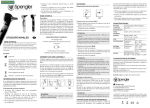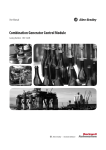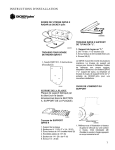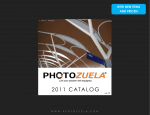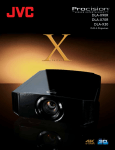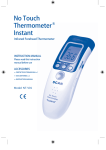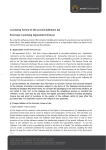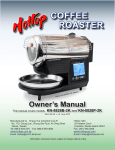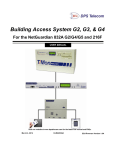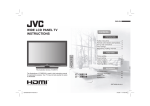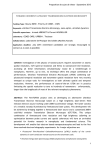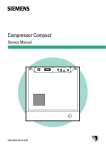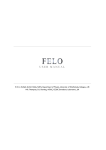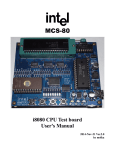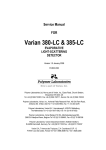Download OLED Lighting
Transcript
OLED LIGHTING for New Lighting Products A bright future ahead – OLED Lighting Organic light-emitting diodes offer an entirely new way to create with light: pure, sophisticated and beautiful. Organic light-emitting diodes (OLED) are an entirely new way for architects, designers, system integrators, planners and luminaire makers to create with light. OLED devices are ultra-flat and emit very homogeneous light. The OLED grants a high degree of design freedom to users. By combining color with shape OLEDs offer an exciting new way of decorating and personalizing surroundings with light. Area light source OLED is the only lighting technology capable of creating an embedded light emitting surface. The illuminating surface does not need diffusers or other functional ‘wrappings’ and can function both as lamp or luminaire. Ultra slim devices OLEDs are semiconductor devices made of thin organic material layers with a thickness just 1/50th that of a human hair. The total thickness of the resulting OLED luminaire is thus only limited by the thickness of the glass, metal or other substrate used. Design flexibility OLEDs offer superior patterning and homogeneity for individual shapes of signage. Illuminated pictograms, patterns or words can be predefined on the OLED substrate. Transparency OLEDs made on glass substrate can be transparent in the off state. This feature enables special lighting applications, e.g. windows or furniture with transparent or translucent elements. Color quality OLEDs emit a very soft and attractive light and the quality of the light comes very close to sunlight. To the human eye, the perception of colors is very high with this light source. Color tunability Based on a specific device structure of Novaled OLEDs and driving electronics it is possible to dynamically switch between white light shades and other colours. Long lifetime Current lighting sources require regular replacement cycles due to limited lifetime. The inherently long lifetime potential of standard Novaled OLEDs and the Novaled Liternity technology address this issue. Energy efficiency Lighting applications use around 20% of the world’s electricity. OLEDs have the potential to be more efficient than current energy saving light bulbs. Novaled OLEDs can be up to three times more efficient than conventional OLEDs. Clean technology OLEDs will also make a significant contribution to sustainability due to their environmentally friendly materials and reduced packaging requirements. The beauty of OLED light: Novaled Lighting Technology Novaled technology delivers high quality OLED light, long device lifetime and low power consumption. A new light source emerges OLED combines energy efficiency with a very natural and pleasing light. The white light of Novaled OLEDs reaches a Colour Rendering Index (CRI) of up to 95 so the accuracy of perceived object colours comes very close to that experienced under sunlight. The classic incandescent light bulb fulfilled that need, but its very low energy efficiency has led to its progressive banning in many countries. Neither fluorescent tubes, compact fluorescent bulbs or inorganic LEDs can deliver light spectra similar to that of the sun. Reasons for outstanding light quality of OLED ˘ entire visible light spectrum can be covered without any sharp peaks ˘ specific Novaled device architecture allows for almost any shade of white ˘ OLED white light is located slightly underneath the black body curve in the CIE diagram ˘ OLEDs can attain high CRI values ˘ no “green dip” such as inorganic LEDs suffer from The Novaled technology enables daylight-like OLEDs with a long lifetime and very low power consumption which can be as low as 1/3rd of the consumption of standard OLEDs. These properties make Novaled OLEDs highly appealing for the lighting industry and qualified the Novaled PIN OLED® technology to play a key role in leading European OLED lighting projects like OLLA and OLED100. A new world of lighting The lighting industry is on the cusp of a revolution with OLED lighting technology. This unique area light source has an immense potential for entirely new applications in various industry segments. With these devices a variety of futuristic luminaires, artistic light sculptures and signage can be brought to life. OLED is not limited to being just a source of light but also functions as furniture elements such as mirrors and surfaces or parts of interiors, rooms, buildings and more. OLED Exit Sign Willing/Novaled As a light source and design element OLED fit perfectly in: ˘ Design Light: Luminaire, Fitting & furnishing ˘ General Light: Luminaire, Fitting & furnishing ˘ Appliance: White Goods, Controls, Signage ˘ Industrial: PDT, Machine vision ˘ Transport: Aerospace, Automobile ˘ Construction and Smart surface: Interior (Window, Wall, Mirror), Façade, other Together with partner companies, Novaled did first concept studies on OLED lighting applications: “Victory” Novaled/Wolfram Design Trilux “Enspiro” Concept study Trilux/Novaled Fasten Seat Belts Sign Airbus/Novaled Applications with OLED Novaled offers customized OLEDs on glass in different sizes and colors and in addition can process OLEDs on metal substrates such as steel or aluminium. “Palm frond” Novaled/Wolfram Design OLED parking light Novaled/Magneti Marelli Partition wall Novaled OLEDs on metal can provide additional value: Easy integration of OLEDs in modules or systems ˘ Direct soldering onto the substrate ˘ Connector options like magnetic clipping Thermal management ˘ Metal substrate is a much better thermal conductor than glass ˘ Increased lifetime and more homogeneous light emission under temperature stress Bill of materials ˘ Substrate can function as one of the OLED electrodes ˘ More robust and less need of support framing Design freedom ˘ Appealing and highly reflective off state appearance ˘ Bended applications will be possible in future “4 x 4 is 34” Ingo Maurer/Novaled The OLED Lighting User’s Manual Technology, market and practical insights for all involved in the lighting business All you want to know about OLEDs – the OLED Lighting User’s Manual provides indepth coverage of technological, marketing and practical aspects related to OLED lighting. It describes and positions the state-of-the-art technologies for organic and inorganic lighting to facilitate the appreciation of the OLEDs’ unique selling points. It brings a revolutionary perspective on the lighting market and its value chain to support a wide range of business considerations. The Manual also describes novel case studies to help the reader understanding what it takes to make an OLED luminaire. This is a complete guide to OLED lighting. The objectives of this OLED lighting report is to: ˘ provide a reference point for OLED outsiders and lighting experts wondering why and when they should engage into OLED for lighting ˘ help the reader to appreciate the USPs and challenges of OLEDs at various application levels ˘ offer the basis to model a possible OLED lighting business plan: from technology to market to product levels “ZigZag” Novaled/Wolfram Design )NTEGRATED OLED lighting can be thought of as a “thin film” lighting technology. With this in mind, the de- /,%$,IGHTING¯READYFORTAKEOFF Antibiotics Fight infection Sulfanilmide Pacemaker Extend life The other losses occur due to the refactive index mismatch between the organic layer and the Satori Kato Nuclear Energy Cheap electricity substrate (guided modes) and the substrate and air (substrate modes). To extract the substrate mode, light extracting structures can be attached on the substrate, which are then called external extracting structures. These external extracting structures are films that have microlens arrays, Bayer Prontosil London, first resuscitation Instant coffee Convenience Rutherford, split atom Fermi, nuclear fission First commercial station, UK, 50MW Zipper Convenience over hook Patent Packet networks, ARPANET GLS bulb Edison long-lasting filament* Electric light In order to extract the light from the organic layers, a light extracting structure is embedded inside the OLED. It is typically a scattering layer that is embedded between the ITO and the substrate. Instead of scattering layers, one can also use structured ITO or photonic crystal layers GE LED Long life, efficiency between the ITO and substrate. The light propagates in the plane of the thin film structure and GE, Visible red OLED Thin, flat light 1900 Conceived/ Invented 1920 Philips** 5% share lamps Nichia blue 15% Osram revenue 1940 1960 Introduced/ Key market milestone 1980 *1,200 hrs 1. No outcoupling improvement Wolfram Design OLED stack Metal cathode OLED stack Metal cathode 2. Scattering layer to improve energy extracting from OLED into substrate a new value proposition is created. In such cases the lighting function would be part of a holistic presence of lighting products and concepts at recent design and lighting exhibitions. At present, the OLED lighting industry is very young and technology driven, contrasting the lighting indus- Exhibit 7.17: Novaled light sculpture “Palm Frond” design concept. potential of the market for its lighting products and services. In the scheme of any self-fulfilling prophecy, connecting those two self-serving ends is the means to success. /,%$INGENERALLIGHTING Against this background there is a need to move the discussion beyond technology and onto the application level. There is also a need to reset short term expectations, which appear to be infected with visions of fully flexible and extremely cheap lighting. This should be achieved by dem- $ESIGN Source: Novaled AG OLEDs are thin area light sources emitting uniform diffuse light. This technology enables light- the lighting market. However, the overwhelming interest in the technology rests on the assump- ing capability to be directly embedded in architectural materials, such as metal and glass. OLEDs tion that OLED lighting can become a mainstream lighting technology and capture a significant share of a $90 billion global lighting market. do not require light distribution optics - OLED lighting is pure lighting. At present, a typical 10x10 OLED module may provide a light output of 50 to 100 lumens when operated in a normal range of 2,000 to 5,000 cd/m2. This means that the equivalent of 10 pieces space, but also not producing uniform illumination and needing to be combined with optical light of current 10cmx10cm OLEDs are required to replace a single 1,000 lumen lamp (efficiency loss the total integration of lighting and architectural materials – something that is not possible today. In addition, both on-state and off-state can be utilized for decorative impact. Design background 0ARAMETER %MBEDDED #ONSTRUCTION 3MARTSURFACE !PPEARANCE LOOKHOMOGENEITY ½TSINTOSURROUNDING PHYSICALSPACE &INALLAYEROFSTRUCTURE (ARMONYWITH DmCORSUPPORTSTACTILE RESPONSE &ORMFACTOR THINLOWWEIGHT 3URFACEULTRATHIN %NHANCEINSTALLATION CONVENIENCEINLARGE AREA 3AVESPACECOMBINE WITHOTHERFUNCTIONS try which is very experienced in delivering end-user solutions. The successful conversion of market interest into commercial products requires a high level of financial investment in the OLED lighting industry. This in turn requires confidence in the growth There is a growing appreciation that OLED lighting will find acceptance in specific segments of Scattering layer ITO anode ent OLED can act as a luminaire at night. The original functional properties are preserved and onstrating that OLED lighting is already a viable, exciting and unrivalled lighting technology. ,IGHTSCULPTURE±0ALM&ROND² Substrate The key to the successful use of OLED lighting technology may be to consider OLED as an additional functional layer on top of the existing function, e.g. a skylight combined with a transpar- high color rendering properties and this results in a very pleasing and comfortable light. Furthermore, they are fully dimmable, can be switched on and off without any time delay, and already 2020 Source: Wikipedia and named companies ITO anode but the adoption of thin internal wall paneling or artificial windows can already be envisaged. OLEDs are thin area light sources that emit uniform diffuse light. White OLEDs display very **integr. ballast 2000 Exhibit 4.19: Timescale from invention to mass market for notable inventions Substrate wall panels, ceiling tiles and glazing units. Realization of illuminating facades will take some years to result in a fundamental change. Evidence that commercial interest in this sector is increasing comes via new product-level announcements from companies engaged in OLED lighting technology and a surprisingly strong Kodak, diode Ingo Maurer table Lumiblade / Orbeos 1880 mercial companies expressing confidence in this new solid-state lighting technology. Whereas in the flat panel display market, OLED technology is seen as an evolutionary replacement for LCD technology, the unique technical features of OLEDs as regards lighting applications are expected technology that can deliver a mirror-like appearance or full transparency in the off-state. CERN WWW project Tungsram filament, 50m sockets USA CFL Replace incandescent scattering increases the amount of light going out of the organics and into the substrate. as the photovoltaic industry is developing integrated energy generation products. The advent of OLED lighting technology as embedded lighting opens up the path to construction elements, e.g. exhibit impressive energy efficiencies and operating lifetimes. There is currently no other lighting Modern zipper Internet Communication shaped structures, shaped substrates and silicon particles. Siemens-Elema, implantable Nescafé brand introduced velopment of “Building Integrated Solid State Lighting” can be imagined much in the same way The increasing viability of OLED as a source of light has led to an increasing number of com- 0ERFORMANCE LIFETIMELUMEN -EETREFURBISHMENT CYCLE -AINTAINFAlADEINTEG RITYEGNOHOLES 2EGULARUPGRADETO LATESTTECHNOLOGY #OLOR MATCHINGSTABLE REPRODUCIBILITY -ATCHTHEDESIGNOR MATERIALSOF½TTINGS 7IDERANGEOFDmCOR OPTIONSLONGRANGE STABILITY #USTOMISATIONOR PERSONALIZATION 3AFETY PHYSICALSTABILITY ½RERESISTANCE ROBUSTAGAINST½RE BREAKAGEOUTGASSING ROBUSTAGAINST½RE BREAKAGEOUTGASSING ROBUSTAGAINST½RE BREAKAGEOUTGASSING 3USTAINABILITY POWERMATERIALS PACKAGING ,ESSMATERIALS VSALTERNATIVE #ONFORMTOSTANDARDS RECYCLING #OHERENTEF½CIENCY MESSAGE EGLOWENERGY Exhibit 6.19: OLED attributes for integrated lighting Source: Novaled AG Conventional lighting schemes use linear and point sources, not only occupying a volume of This luminaire concept was designed in late 2009 and is inspired by a palm frond. It is intentionally spare in design in order to emphasize the OLEDs. The stem gives the piece its structure and it is conceived as a reversible piece which can be used in suspension or free-standing. in typical luminaires can close this gap) in the near term. management fixtures. OLED lighting offers designers a new lighting design platform that enables It has the additional dichotomy of two different perspectives. Side-on, it evokes the idea of a large Substrate Scattering layer ITO anode OLED stack Metal cathode 3. Microlens Array (MLA) to improve energy extracting from OLED into air avian wing with main feathers or alternatively the form of a mammal with the rib cage attached to Current module efficiency of 15 to 25lm/W is on par with incandescent and halogen light sources a curved backbone. It could also indeed project the concept of an angel`s wing. Viewed edge-on, the piece is seen as a bare spine and only the glow of the OLEDs betrays some hidden depth to at lamp level, but compared to LED and FL, which promise 50 to 100lm/w at lamp level, there 4HE/,%$,IGHTING5SER´S-ANUAL.OVALED!'ÀWWWNOVALEDCOM appears to be a significant gap. However, in the next 5 years OLED should be able to close the the piece. 4HE/,%$,IGHTING5SER´S-ANUAL.OVALED!'ÀWWWNOVALEDCOM Other colors and forms are possible. Alternative connection and driving options could be incorporated to develop active lighting effects, such as downward or upward sweeping, and create color Exhibit 3.8: Approaches to improve light outcoupling Source: Novaled AG variation according to the season or time of day. 4HE/,%$,IGHTING5SER´S-ANUAL.OVALED!'ÀWWWNOVALEDCOM 4HE/,%$,IGHTING5SER´S-ANUAL.OVALED!'ÀWWWNOVALEDCOM Substrate 4HE/,%$,IGHTING5SER´S-ANUAL.OVALED!'ÀWWWNOVALEDCOM Content overview OLED Lighting User’s Manual 1. Introduction 1.1. OLED Lighting – ready for takeoff 1.2. The solid-state lighting century 1.3. Scope of report 20 21 21 22 2. OLED application & design aspects 2.1. What makes OLED lighting so unique? 2.2. Main application areas for OLED technology 2.3. OLED contacting and driving 2.4. OLED on glass 2.5. Transparent OLED 2.6. OLED on metal 2.7. Flexible OLED 2.8. Off-state appearance 24 25 27 33 34 35 36 37 38 3. OLED technology – the basics 3.1. Introduction 3.2. How does an OLED work? 3.3. OLED architecture 3.4. Key technology parameters 3.5. Key technology challenges 3.6. OLED manufacturing 4. OLED lighting roadmap 4.1. Lamp technology 4.2. Lighting technology 4.3. International initiatives 4.4. Manufacturing development roadmap 4.5. When will a major OLED lighting industry emerge? 4.6. OLED roadmap 40 41 42 53 54 57 59 66 67 69 74 79 84 88 5. OLED lighting market 5.1. Market drivers 5.2. OLED lighting adoption 5.3. The competitive landscape: Five forces analysis 5.4. OLED lighting market 5.5. Lighting market structure 92 93 102 6. How OLED will change lighting 6.1. The OLED lighting revolution 6.2. Nature of OLED lighting products 6.3. Lighting requirements 6.4. Application areas for OLED Lighting 140 141 145 150 155 7. Novaled OLED luminaires – concept studies, designs & prototypes 7.1. Design concepts 7.2. Design prototypes 168 169 171 Appendix 186 110 116 132 Following flyers are available: /,%$ /,%$ #/-0!.9 4%#(./,/'9 0%2&/2-!.#% FOR$ISPLAY,IGHTING!PPLICATIONS COMPANY FOR$ISPLAY,IGHTING!PPLICATIONS TECHNOLOGY+ PERFORMANCE Novaled AG Tatzberg 49 01307 Dresden Germany Tel +49(0)351/7 96 58-0 Fax +49(0)351/7 96 58-29 [email protected] /,%$ -!4%2)!,3 FOR$ISPLAY,IGHTING!PPLICATIONS MATERIALS /,%$ ,)'(4).' FOR.EW,IGHTING0RODUCTS LIGHTING /% /2'!.)#%,%#42/.)#3 FOR&LEXIBLEANDLIGHTWEIGHT!PPLICATIONS ORGANIC ELECTRONICS /,%$ +./7(/7#/.35,4).' FOR&UTURE-ANUFACTURERS3UPPLIERS KNOW HOW +CONSULTING Novaled AG is a world leading company in the OLED field specialized in high efficiency long lifetime OLEDs and an expert in synthetic and analytical chemistry. The company offers its Novaled PIN OLED® technology along with its proprietary OLED materials as well as R&D contracting, manufacturing of customized OLEDs and further services. Novaled has a strong IP position in OLED technology based on more than 400 patents granted or pending. www.novaled.com rev18gb








